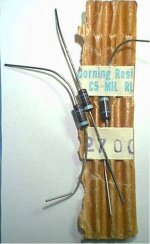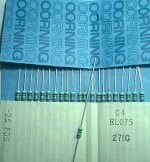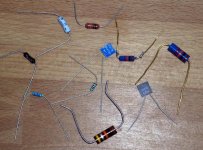Bobken said:Hi UrSv,
What about ---AB---AB v ---BA---BA , as well !
Then you have the parallel AB v BA
AB BA
Regards,
Testing ---AB---AB--- v ---BA--BA--- would be testing the greater perpective of testing --AB-- v --BA-- i.e. normal single resistor directionality.
UrSv said:
Testing ---AB---AB--- v ---BA--BA--- would be testing the greater perpective of testing --AB-- v --BA-- i.e. normal single resistor directionality.
You are absolututely right here, and this a technique which I have referred to before which usually 'exaggerates' any such effects and makes the (any?) results easier to hear!

Also, see my comments added to the earlier post which were added after your reply.
Regards,
Umm, Yes If You Accept That Wires Can Be Directional, Then Why Not Other Components..
I agree that this is an obvious experiment, and no despite my thought experiments I have not gotten around to doing any definative tests, but based on my wire direction experiments, I fully expect this to be a factor.
Eric.
I agree that this is an obvious experiment, and no despite my thought experiments I have not gotten around to doing any definative tests, but based on my wire direction experiments, I fully expect this to be a factor.
Eric.
Re: Resistors In Oposition.....
Useful for research. No point for use. I have done this on cables and all this does is to degrade sonics from what you hear in the preferred direction.
----------------------------------------------mrfeedback said:Anybody tried using two resistors in parallel in opposite directions and noted any sonic differences ?.
Or two half value resistors in series, wired in oppsite directions ?.
Eric.
Useful for research. No point for use. I have done this on cables and all this does is to degrade sonics from what you hear in the preferred direction.
For those who may be interested in the Alpha bulk-metal foil resistors, here is the URL.
http://www.alpha-elec.co.jp/english/eflash/index.html
hope this helps, jonathan carr
http://www.alpha-elec.co.jp/english/eflash/index.html
hope this helps, jonathan carr
"Useful for research. No point for use. I have done this on cables and all this does is to degrade sonics from what you hear in the preferred direction."
Strange, I have found making the cables to be nondirectional always a sonic improvement - LR imaging, depth imaging etc.
Eric.
Strange, I have found making the cables to be nondirectional always a sonic improvement - LR imaging, depth imaging etc.
Eric.
DIRECTIONS.
Hi,
Hi Eric-San,
I admit to being a bit puzzled by the approach you take in an attempt to cancel out directivity.
For instance in your star quad example; wouldn't it be better to correctly align all conductors?
I.e. the send conductors in their preferred direction and the return in the opposite direction?
Wouldn't that be better?
Cheers, 😉
Hi,
Strange, I have found making the cables to be nondirectional always a sonic improvement - LR imaging, depth imaging etc.
Hi Eric-San,
I admit to being a bit puzzled by the approach you take in an attempt to cancel out directivity.
For instance in your star quad example; wouldn't it be better to correctly align all conductors?
I.e. the send conductors in their preferred direction and the return in the opposite direction?
Wouldn't that be better?
Cheers, 😉
Hi Frank,
As per my star-quad example, eack leg (A & N) is made from two strands, in reversed direction, so as to make each leg non directional in it's own right - well that is the theory anyway.
This is not the same as your suggestion.
By the above method, I got fantastic depth imaging.
The downside perhaps was that AP was then clearly discernable, meaning that you have to get up every second track to correct it.
In the Correct AP, this gave me the best imaging I have had.
Eric.
As per my star-quad example, eack leg (A & N) is made from two strands, in reversed direction, so as to make each leg non directional in it's own right - well that is the theory anyway.
This is not the same as your suggestion.
By the above method, I got fantastic depth imaging.
The downside perhaps was that AP was then clearly discernable, meaning that you have to get up every second track to correct it.
In the Correct AP, this gave me the best imaging I have had.
Eric.
Corning resistor test
After hearing talk of the Corning tantalum resistors on this thread, I got several different types of Cornings hoping to get clarification from the group as to which spec number is tantalum—see pics.
All of my tests here were on the cathode of a 437a in a 300B SET. My previous impressions re the tants are from pre-amp tweaking. The only source was CD as my TT is not setup at this time.
Of the Corning types I was able to get, the two pictured are the only ones that are non-magnetic. The 1/2W brown ones sound the most like Shinkos. The highs are sweet yet nicely extended extended (making Radio Hut carbon film and no-name, molded CC sound very closed in indeed), but like the Shinkos, at least to my ears, the lower mids and the bass are cloyingly sweet and lack leading edge detail and impact. The 1/4W bluish ones are more mechanical sounding and lack extended highs but the bass/lowmid has more detail and dynamic impact.
After I went back and forth a couple of times, I put in some new AB 1W of the same value (all 270R). To my surprise, the highs were about as extended as the brown Cornings but overall the sound, especially in the midrange was more natural – horns and vocals sounded more pleasing even though the bass was less slightly less detailed and dynamic.
After hearing talk of the Corning tantalum resistors on this thread, I got several different types of Cornings hoping to get clarification from the group as to which spec number is tantalum—see pics.
All of my tests here were on the cathode of a 437a in a 300B SET. My previous impressions re the tants are from pre-amp tweaking. The only source was CD as my TT is not setup at this time.
Of the Corning types I was able to get, the two pictured are the only ones that are non-magnetic. The 1/2W brown ones sound the most like Shinkos. The highs are sweet yet nicely extended extended (making Radio Hut carbon film and no-name, molded CC sound very closed in indeed), but like the Shinkos, at least to my ears, the lower mids and the bass are cloyingly sweet and lack leading edge detail and impact. The 1/4W bluish ones are more mechanical sounding and lack extended highs but the bass/lowmid has more detail and dynamic impact.
After I went back and forth a couple of times, I put in some new AB 1W of the same value (all 270R). To my surprise, the highs were about as extended as the brown Cornings but overall the sound, especially in the midrange was more natural – horns and vocals sounded more pleasing even though the bass was less slightly less detailed and dynamic.
Attachments
RE:Corning resistor test
Hi,
Your description of the sound of the blue Cornings (ordinary MF) correlates nicely with mine as does your description of a generic tant.
Pretty soon you'll know exactly what to order,😉
Hi,
Your description of the sound of the blue Cornings (ordinary MF) correlates nicely with mine as does your description of a generic tant.
Pretty soon you'll know exactly what to order,😉
I checked some resistors today. Allen Bradly sounds OK without any nastities, untill you comapre them to Rikens. Rikens are just more refined, with more air, bigger depth and are just simply more involving. I also compared Vishay S102 and they seem to be very neutral. Comparing to Rikens they don't have that much treble energy and seem to be more laid back, while Rikens put empahsis on high frequencies, which are more forward and more pronounced, which also seems to show more detail. The blue Vishay Sfernice don't sound as good as S102 Vishays (vocal isn't very natural sounding). Although I tried all resistors on the input of my AX amp, which works only above 100Hz, my impression is that Rikens have also more extended bass. It would be hard to decide which resistor to use, it would depend greatly on the rest of a system and Rikens provide more lively tone, while Vishays are more laid back and smooth. Also, 1W Riken sounds better than same value in 0.5 wattage.
I also tried other resistors and I found that the brown Dales, used by ML and Krell, are not bad sounding, probably better than the blue RN55D Dales and Beyschlag resistors which are more bright. The blue Panasonics are not bad either, with a bit of thinning at the top. This time Holco didn't impress me much, they are indeed dry sounding without much air and extention.
I also tried other resistors and I found that the brown Dales, used by ML and Krell, are not bad sounding, probably better than the blue RN55D Dales and Beyschlag resistors which are more bright. The blue Panasonics are not bad either, with a bit of thinning at the top. This time Holco didn't impress me much, they are indeed dry sounding without much air and extention.
Attachments
Member
Joined 2002
so your saying if i had a red car and i painted it brown it will go faster. SWEET... IM getting my car painted.
HOW the dam hell is a brown resister sound better than a blue resister. WHAT Is the big difrence. I see no point..
HOW the dam hell is a brown resister sound better than a blue resister. WHAT Is the big difrence. I see no point..
Peter,
Vishay need at least 400 hours of burn in to give full potential sounding. Old Holco and Resista seem to be happy with
100 hours.
Vishay need at least 400 hours of burn in to give full potential sounding. Old Holco and Resista seem to be happy with
100 hours.
I've heard about long time burning periods, but it makes any comparison even harder to perform.
Jason,
It is not color that's important, but using color is easier to describe the type of a resistor. So once again, color has nothing to do with the sound, but you knew that already, I guess?😉
Jason,
It is not color that's important, but using color is easier to describe the type of a resistor. So once again, color has nothing to do with the sound, but you knew that already, I guess?😉
RESISTORS.
Hi,
Peter you just made my day.
Your description is accurate and correlates with my own findings.
My favs today are the Riken for anything that has to carry some voltage and the Vishay S102 for anything that is in series or shunt with the signal path.
The old Holcos are simply too subdued in sound and may be fine in applications where you have to tune the sound a bit, for overall use they are not my cup of tea.
Cheers,😉
Hi,
Peter you just made my day.
Your description is accurate and correlates with my own findings.
My favs today are the Riken for anything that has to carry some voltage and the Vishay S102 for anything that is in series or shunt with the signal path.
The old Holcos are simply too subdued in sound and may be fine in applications where you have to tune the sound a bit, for overall use they are not my cup of tea.
Cheers,😉
Member
Joined 2002
400 hours burn i
I think that is better to buy used...at last they are ready for action!...
Jorge
Vishay need at least 400 hours of burn in to give full potential sounding.
I think that is better to buy used...at last they are ready for action!...

Jorge
SECOND HAND RESISTORS.
Hi,
The difference can be heard straight away, burning them in only makes things better in the long run.
Ciao,😉
Hi,
I've heard about long time burning periods, but it makes any comparison even harder to perform.
The difference can be heard straight away, burning them in only makes things better in the long run.
Ciao,😉
- Status
- Not open for further replies.
- Home
- Design & Build
- Parts
- resistor comparison test - tantalum?



